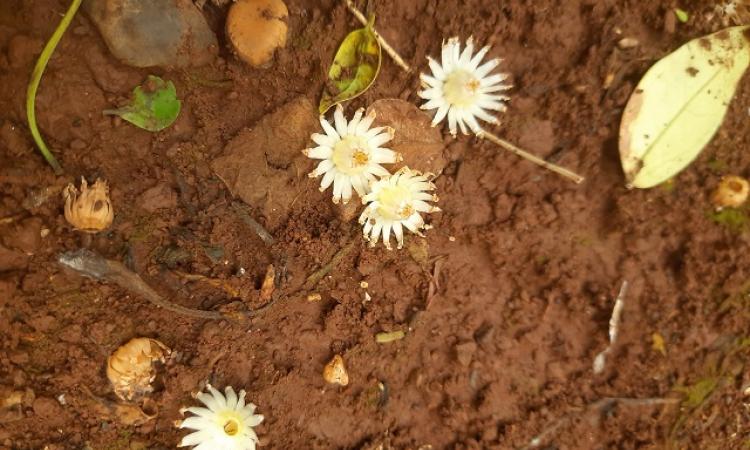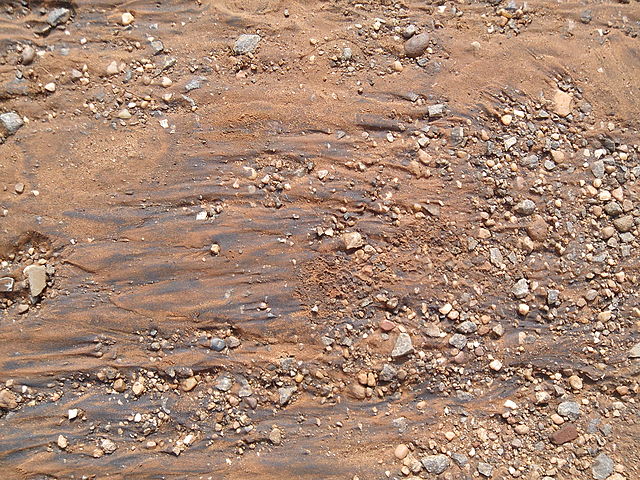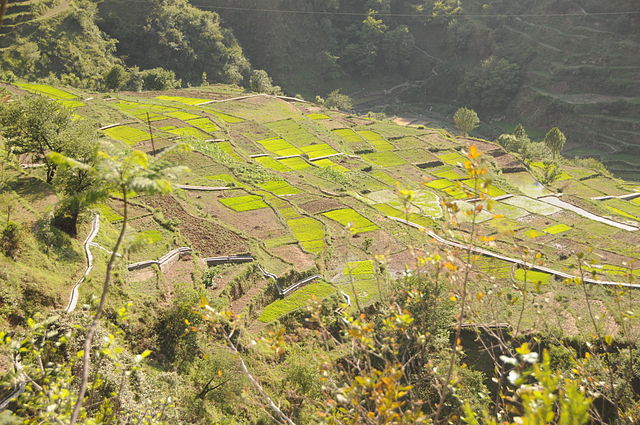
How is soil formed?
Soil is the uppermost part of the Earth’s crust and is formed mainly due to the weathering of rocks under the influence of climate, vegetation, topography of the area and the type of rocks in the area. Healthy soil is extremely important for agriculture and is the foundation of the food system.
What is healthy soil and why is it important for agriculture?
The concept of soil health is based on soil properties and the critical functions it performs and supports. Thus soil quality has been defined as:
"The continued capacity of soil to function as a vital living system, within ecosystem and land-use boundaries, to sustain biological productivity, maintain the quality of air and water environments, and promote plant, animal, and human
health” (Patra, Lenka and Biswas (2016) Soil health assessment and management: Issues and strategies, Indian Journal of Fertilisers, 17.)
The soil functions related to crop production include infiltration and storage of water, retention and cycling of nutrients, pest and weed suppression, detoxification of harmful chemicals, carbon sequestration and production of food and fibre.
To know more on soil health assessment, read here
What are the types of soils found in India?

Soil map of India (Image Source: http://nroer.in/gstudio/resources/images/show/35270/ via Wikimedia Commons)
India has a variety of soil groups that have been classified on the basis of geology, topography of the area, fertility, chemical composition and physical structure.
The Indian Council of Agricultural Research (ICAR) has classified Indian soils into eight major groups:
Alluvial soil: forms the largest and the most important of the soil groups in India that covers about 45.6 per cent of the total land area of the country. This soil supports the growth of wide variety of crops such as rice, wheat, sugarcane, cotton, jute, potato and vegetables.
Alluvial soils are mainly distributed in the flood plains of Sutlej - Ganga and Brahmaputra from Punjab to Assam, the valleys and plains of river Narmada, Tapti, Mahanadi, Godavari, Krishna and Cauvery.
Black soil: Is derived from the basalt rock under semi-arid conditions and is largely found over the Deccan trap region of the states of Maharashtra, Madhya Pradesh, parts of Andhra Pradesh, Northern part of Karnataka, Gujarat, parts of Tamil Nadu and Rajasthan.
Red soil: Is formed from weathering of granites, gneisses, and crystalline rocks and ranges from poor, thin and light colored soils of the uplands to the fertile dark color soils found in the plains and valley.
Red soils form 29.08 percent of the total soil cover in India and is found in parts of Tamil Nadu, Southern Karnataka , South-East Maharashtra, parts of Madhya Pradesh, Goa, Kerala, Orissa, Bihar, West Bengal, Uttar Pradesh, Eastern Parts of Rajasthan, Assam, Manipur, Tripura, Meghalaya and Nagaland. These soils are ideal for cultivation of ragi, ground-nuts, millets, tobacco and potato.
Lateritic soils: Form 4.30 percent of India’s soil cover and are mainly found highest [oints of the Western Ghats and Eastern Ghats along with Vindhyas and Satpura’s found in States of Karnataka, Kerala, Madhya Pradesh, Maharashtra, Orissa, Assam and Tamil Nadu. This soil is well drained and porous and is useful for both rice cultivation as well as plantation crops like cashew, rubber, tea and coffee.
The arid and desert soils: are found in semi-arid and arid regions of India, namely the western Rajasthan, Southern Haryana, and South-West Punjab and cover an area of about 29 million hectares i.e., 1.42 lakh sq kilometres. These soils are not suitable for growing crops and the ones that are grown in these areas mainly rely on irrigation.
Mountain soils: are found all along the slopes of mountains and hills and formed mainly due to decomposition of organic matter from the forest. The characteristics of these soils differ from region to region depending on climate, vegetation and topography. These soils are very fertile and can be useful to grow tea, coffee, spices and tropical fruits.
Alkaline and saline soils: These soils are seen in saline, arid and semi-arid parts of Rajasthan, Punjab, Uttar Pradesh, Haryana, Gujarat and Maharashtra. These soils are generally not good for cultivation and range from sandy to loamy sand and are highly pervious with low water retaining capacity.
Peaty soils: Occur in hot humid conditions and are black, heavy and highly acidic with large amount of soluble salts. These types of soils are mainly found in Orissa, the Sunderbans in West Bengal, parts of Bihar, Uttar Pradesh and Kottayam, Alleppey, districts of Kerala.
Read more on the types of soils here
What is soil erosion?

Soil erosion in Salem district, Tamil Nadu (Image Source: Thamizhpparithi Maari via Wikimedia Commons)
Soil erosion is the process of detachment and transportation of soil particles from the soil mass due to natural factors such as strong winds, heavy rains, flowing rivers, glaciers as well as human activities like deforestation, over grazing, shifting cultivation, over-ploughing of land and other faulty agricultural practices and removal of top soil for industrial or infrastructural purposes.
What is the extent of soil erosion in India?
The average annual rate of soil erosion in the country is 16.35 tonnes per hectare i.e. 5334 million tonnes per year. Of this, about 29 percent is lost to the sea, ten percent is deposited in reservoirs (leading to a reduction in the storage capacity of reservoirs by 1 to 2 percent annually) and the remaining 61 percent continues to get shifted from one place to another.
It is estimated that out of 305.9 million hectares of reported area, 145 million hectares is in need of conservation measures in the country. This different kinds and increasing extent of erosion contribute to rapid conversion of cultivable lands into wastelands. For example, recent evidence shows that about 63.85 million hectares (20.17 percent ) of the total geographical area (328.72 million hectares) of the country has been converted into wastelands.
Where does erosion commonly occur in India?
The problem of soil erosion is common on the steeper slopes with heavy rainfall in states such as Assam, Meghalaya, Manipur, Tripura, Mizoram and the Western Ghats. It also occurs in parts of Maharashtra, Madhya Pradesh, Karnataka, Tamil Nadu and Andhra Pradesh.
What is the history of soil erosion in India?
An increase in soil erosion started when hunting and pastoral life began to change gradually to a sedentary lifestyle. Three important anthropogenic erosion peaks can be recognised in India.
The first occurred at the peak period of river valley civilisations around 3000 years ago, when the need for cultivation led people to cut down forests and remove pastures to increase availability of land.
During the second peak (period 1800 and 1900), emphasis on agricultural export led to conversion of forests and fragile lands to commercial cultivation. For example, during colonial times in India, around 1880–1950, about 20 m ha of forest area was converted to agricultural land. The main focus of the colonial administration was to increase revenue from timber export as well as infrastructure development.
The third peak from the early 20th century extends to current times where pressure on land resources is increasing with more demand for food production. This has forced farmers to develop land for agriculture production and adopt intensive and un sustainable land-use and land-management techniques that can cause high levels of soil erosion. Increasing pressures of urbanisation and industrialisation and anthropogenic activities such as building of roads, dams, construction activities are also increasing the rate of erosion of the soil in India.
Read more here
What are the impacts of soil erosion?
The loss of top layer of the soil can lead to severe depletion and degradation of the soil leading to loss of soil quantity and fertility resulting in fall in agricultural production and productivity.
The annual loss in output of main crops in India because of soil erosion has been estimated to be 7.2 million tonnes which is about 4 to 6.3 percent of annual agricultural production of the country and ranges to a loss in terms of replacement cost from 1 to 1.7 percent of the GDP. As high as 74 million tonnes of major nutrients are lost to soil erosion in India per year.
Siltation is also one of the major off site consequence of soil erosion. Siltation in rivers, canals, tanks and reservoirs reduces their water holding capacity.

Silted river of Bori, a tributary of Tapi (Image: Pooja Joshi Chaphalkar, By-NC-ND 2.0, Flickr Commons)
What are the types of soil erosion?
There are seven types of soil erosion:
- Water erosion: Water erosion is the most destructive form of erosion in India. It includes
- Stream bank erosion
- Seashore erosion
- Splash erosion
- Sheet erosion
- Rill erosion
- Gully erosion
- Slip erosion
- Wind erosion
- Glacial erosion
- Damage due to the excess of salts
- Chemical degradation
- Biological degradation
- Fertility erosion
- Other
Water and wind erosion in India extend over about 162.4 and 167.0 million hectares of area respectively.
Human interventions such as deforestation, overgrazing, extension of agriculture to marginal areas, road construction, land use changes and unscientific cultivation practices have also been identified as major factors leading to accelerated water and wind erosion.
The details on the types and extent of erosion can be accessed here
Conservation and management of soils
Since the causes of soil erosion differ from one area to the other, different methods such as contour tillage, contour bunding, construction of check dams, terrace farming, checking the extension of gullies, strip cropping and shelter belts, afforestation, ban on shifting cultivation, controlled grazing, mixed cropping, mixed farming, rotation of crops and mulching can be undertaken to prevent erosion and improve soil quality.
To know more about the different methods of soil conservation read here
To know more on soil health management practices read here

Terrace farming in Uttarakhand (Image Source: Sharada Prasad CS via Wikimedia Commons)
Efforts made at soil conservation at the national level in India
A number of efforts have been made at the national level at soil conservation in India. For example, this paper informs that, during the first and second Five Year Plans, the Central Soil and Water Conservation Research and Training Institute (CSWCRTI) was established at Dehradun, in 1974.
Soil erosion control and prevention approach in India focuses on the watershed management approach. The Soil Conservation in the Catchments of River Valley Projects (RVP) was started in 1962 and aims at controlling the premature siltation of reservoirs and enhancing productivity of catchment areas through integrated planning of watersheds. This is by undertaking measures such as vegetative hedges, contour/graded bunding, agroforestry, horticulture plantation, silvi-pastoral development, pasture development, afforestation etc.
Integrated Watershed Management in the Catchments of Flood Prone Rivers (FPR) was launched in 1982-83 and is, currently, being implemented in 291 watersheds of 8 catchments located in 8 eight states. It focuses on reducing flood frequency by controlling soil erosion in the catchments of flood prone rivers. The Fifth Drought Prone Area Programme (DPAP) and Desert Development Programme (DDP) also focuses on soil and water conservation while the the National Watershed Development Programme for Rainfed Areas (NWDPRAs) (1990- 91) and the Integrated Wasteland Development Project (IWDP) focused on sustainable utilisation of soil and other resources.
The National Bureau of Soil Survey & Land Use Planning and the Central Soil and Water Conservation Research and Training Institute, The Indian Institute of Soil Conservation (ICAR), the All- India Soil and Land Use Survey and NRSA are now also preparing soil erosion maps at watershed level, state level and country level to address the issue of soil erosion and its management.
Read more on it here
With expanding urbanisation and industrialisation, maintaining the quality of the soil and preventing erosion continues to pose a major challenge for the fast growing economy of India.
/faqs/healthy-soil-crucial-agriculture-india